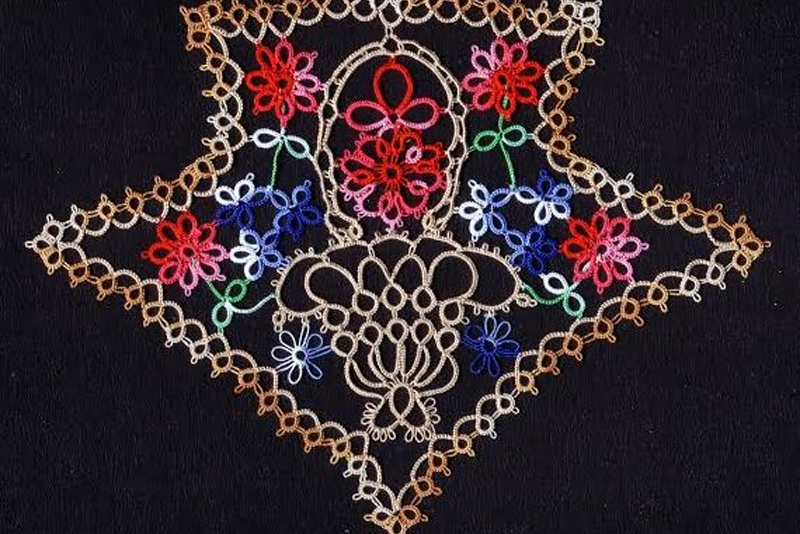Valentine's Day has me thinking of roses but the day is dank, gray and threatens more snow. Hoping for a bit of color for the newsletter I remembered this lovely pattern:

This is a pattern by Denise Munoz and it was tatted by Laura Blanton.
It is one of those images that stick in one's mind. I have always loved it.
It is from a book by Denise that I reviewed many years ago.

"Denise Munoz's ... her work shows years of experience. Each of the 6-point snowflakes and the three multi-point medallions all begins with a classic rosette... All of the motifs can be tatted in one pass and there appears to be no need for the split chain as all outer rows attach at a joining spot on the last round of the center. One pattern would require a split ring. It was a petite booklet (8" x 5.5") with nine patterns."

This classic rosette is an excerpt from Book 3 of the Ribbonwinners series, "Tatting Tiny Treasures: Miniature Tatted Lace for Dollhouses" by Georgia Seitz. This classic rosette is formed with a ring and several picots. The number of picots determines the number of petals on the rose. Begin and end the ring with the same number of stitches and create one less picot than the number of petals desired. For example:
R 2 - 2 - 2 - 2 - 2 close ring.
Create mock picot which is the same length as the other picots.
DO NOT REVERSE WORK.
Simply ROTATE the ring a quarter turn clockwise and begin chaining around the ring making a shuttle join into each picot.
CH 8 + 8 + 8 + 8 + 8
Join last chain into same picot where the chains started. This join may be made directly into the exact spot as before. This means, however, that the thread is pulled up and over with each succeeding join and it becomes highly visible. Or, the shuttle join may be made into the short length of thread from the ball which is on the back side of the join. Remember the ball thread is not involved in the shuttle join so it is just carried forward that short space on the reverse side.
On the second round of chain work, the length of the chain needs to be increased and each segment of chain should have the curve enhanced by gently compressing the stitches to the left before joining.
The number of rounds of chain work is at least three traditionally, but may be increased or decreased as desired. Additional patterns may decorate the edge.
The next round of chains are 10, 12; then the chains with the picots begin and end with 2 DS and have 3 DS between each picot; the last chain segments are 16 DS. Compress before each join.
Here's the latest article from the Tatting site at BellaOnline.com.
Cluny Angel Heart - Dagmar Pezzuto Dagmar Pezzuto Cluny Heart with Angel 2018. Another great cluny pattern which gives us experience is utilizing the negative space in a pattern.
http://www.bellaonline.com/articles/art305063.asp
Please visit tatting.bellaonline.com for even more great content about Tatting. To participate in free, fun online discussions, this site has a community forum all about Tatting located here -
http://forums.bellaonline.com/ubbthreads.php?ubb=postlist&Board=39
I hope to hear from you sometime soon, either in the forum or in response to this email message. I thrive on your feedback! Have fun passing this message along to family and friends, because we all love free knowledge!
Georgia Seitz, Tatting Editor http://tatting.bellaonline.com One of the hundreds of sites at BellaOnline.com







